
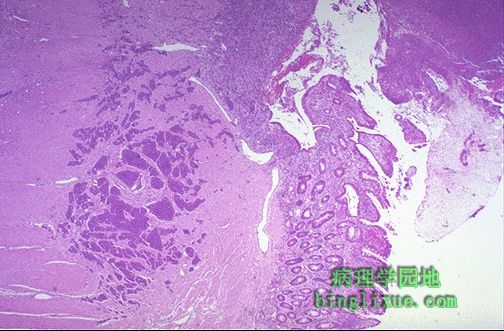 |
类癌是分散的,虽然没有包裹,但在黏膜下层有多个小蓝细胞组成的细胞巢。 The carcinoid tumor is seen here to be a discreet, though not encapsulated, mass of multiple nests of small blue cells in the submucosa. |
 |
高倍镜下,类癌的细胞巢有典型的内分泌外观,有小圆细胞,核小而圆、细胞浆粉红色到浅兰色。很少有恶性类癌发展到体积很大。 转移到肝脏的类癌很少导致类癌综合征。 At high magnification, the nests of carcinoid tumor have a typical endocrine appearance with small round cells having small round nuclei and pink to pale blue cytoplasm. Rarely, a malignant carcinoid tumor can occur as a large bulky mass. Metastatic carcinoid to the liver can rarely result in the carcinoid syndrome. |
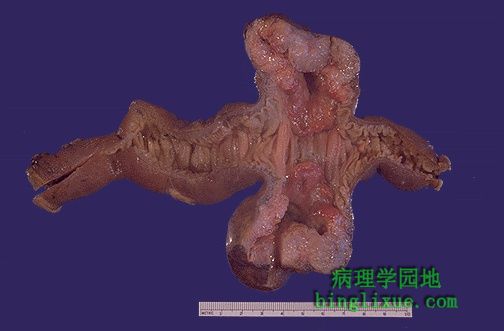 |
最常见的小肠肿瘤是转移而来的,如图所示,包块导致了小肠梗阻。原发瘤主要位于附近的结肠、卵巢、胰腺和胃。 The most common neoplasm in small bowel is a metastasis as seen here. This mass caused local obstruction. Primary sites are often from nearby colon, ovary, pancreas, and stomach. |
 |
腺癌源于Vater壶腹。原发性小肠腺癌很少见,但大部分发生在壶腹区域,在那里它们通过堵塞胆汁和胰液的输送而产生症状。 This adenocarcinoma arose in the ampulla of Vater. Primary small intestinal carcinomas are very rare, but the majority of those that do occur arise in the region of the ampulla, where they may become symptomatic through biliary or pancreatic duct obstruction. |
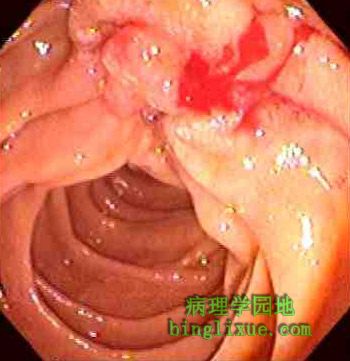 |
包块在食管胃十二指肠内窥镜检查的表现。 The appearance of such a mass on esophagogastroduodenoscopy is seen, and following placement of a stent for drainage. |
 |
引流管。 |
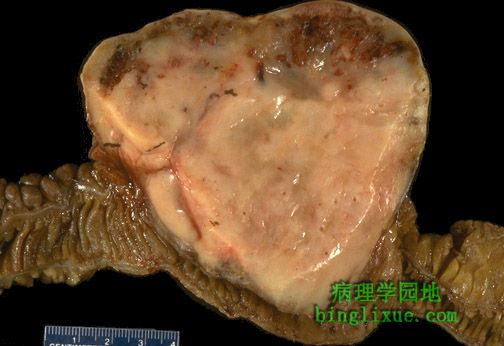 |
小肠平滑肌肉瘤。大体上看是个肉瘤,体积大而且恶性。这个部位发生肉瘤不常见,但必须与别的类型的肿瘤区别。 This is a leiomyosarcoma of the small bowel. As with sarcomas in general, this one is big and bad. Sarcomas are uncommon at this site, but must be distinguished from other types of neoplasms. |
 |
可见大的蓝色的非霍奇金淋巴瘤细胞浸润黏膜层。 The large blue non-Hodgkin's lymphoma cells can be seen infiltrating through the mucosa. |
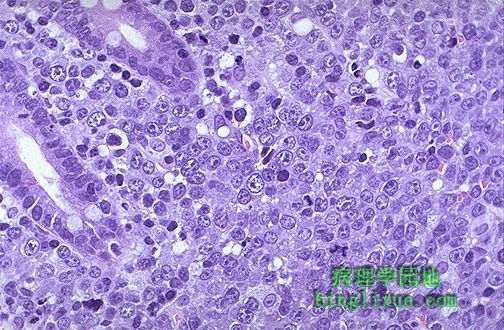 |
高倍镜非霍奇金淋巴瘤细胞有明显的染色质浓缩,偶尔可见处于核分裂。 At high magnification, the non-Hodgkin's lymphoma cells have prominent clumped chromatin and nucleoli with occasional mitotic figures. |
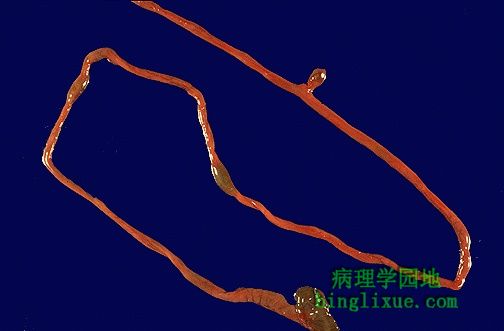 |
肠的先天异常主要包括憩室或闭锁,肠道闭锁常与别的先天性异常有关。图示常见的胃肠道Meckel憩室。记住2这个数字:大约2%的人具有这种疾病,病灶常距离回盲瓣2英尺的地方。 Congenital anomalies of bowel consist mainly of diverticulae or atresias which are often in association with other congenital anomalies. Seen here is the most common congenital anomaly of the GI tract--a Meckel's diverticulum. Remember the number 2: about 2% of people have them; they are usually located 2 feet from the ileocecal valve. |